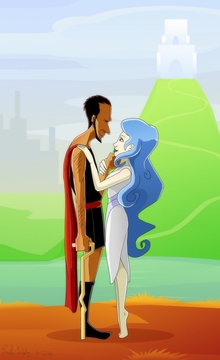Hephaestus
(Greek Hēphaistos) was a
Greek god, whose Roman equivalent was Vulcan. He was the god of technology,
blacksmiths, craftsmen, artisans, sculptors, metals, metallurgy, fire and
volcanoes. Like other mythic smiths but unlike most other gods, Hephaestus was
lame, which gave him a grotesque appearance in Greek eyes. He served as the
blacksmith of the gods, and he was worshipped in the manufacturing and
industrial centers of Greece, particularly in Athens. The center of his cult was
in Lemnos.
Hephaestus’s
symbols are a smith’s hammer, an anvil and a pair of tongs, although sometimes
he is portrayed holding an axe.
Hephaestus
was identified by Greek colonists in southern Italy with the volcano gods
Adranus of Mount Etna and Vulcanus of the Lipari Islands. His forge was moved
there by the poets. The first-century sage Apollonius of Tyana is said to have
observed, “there are many other mountains all over the earth that are on fire,
and yet we should never be done with it if we assigned to them giants and gods
like Hephaestus”.
An
Athenian founding myth tells that Athena refused a union with Hephaestus because
of his unsightly appearance, and that when he became angry and forceful with
her, she disappeared from the bed. His ejaculation landed on the earth,
impregnating Gaia, who subsequently gave birth to Erichthonius of Athens; then
the surrogate mother gave the child to Athena to foster, guarded by a serpent.
Hyginus made an etymology of strife (Eri-) between Athena and Hephaestus and the
Earth-child (chthonios). Some readers may have the sense that an earlier,
non-virginal Athena is disguised in a convoluted re-making of the myth-element.
At any rate, there is a Temple of Hephaestus, the Hephaesteum miscalled the “Theseum”,
located near the Athenian agora, or marketplace.

Anya Stankus
and Tony Hernandez take to the
seductive tale of Greek mythology’s “Hephaestus:
A Greek Mythology Circus Tale”
On the island of Lemnos, his consort was the sea nymph Cabeiro, by whom he was the father
of
two metalworking gods named the Cabeiri. In Sicily, his consort was the
nymph Aetna, and his two sons, gods of Sicilian geysers called Palici.
Homer
makes Charis the wife of Hephaestus. However, according to most myths,
Hephaestus is a husband of Aphrodite, who commits adultery with Ares.
Hephaestus
crafted much of the other magnificent equipment of the gods, and almost any
finely-wrought metalwork imbued with powers that appears in Greek myth is
said to have been forged by Hephaestus: Hermes’ winged helmet and sandals,
the Aegis breastplate, Aphrodite’s famed girdle, Agamemnon’s staff of
office, Achilles’ armor, Heracles’ bronze clappers, Helios’ chariot as
well as his own due to his lameness, the shoulder of Pelops, Eros’ bow and
arrows. Hephaestus worked with the help of the chthonic Cyclopes, his
assistants in the forge. He also built automatons of metal to work for him.
He gave to blinded Orion his apprentice Cedalion as a guide. In one version
of the myth, Prometheus stole the fire that he gave to man from
Hephaestus’s forge. Hephaestus also created the gift that the gods gave to
man, the woman Pandora and her pithos.
